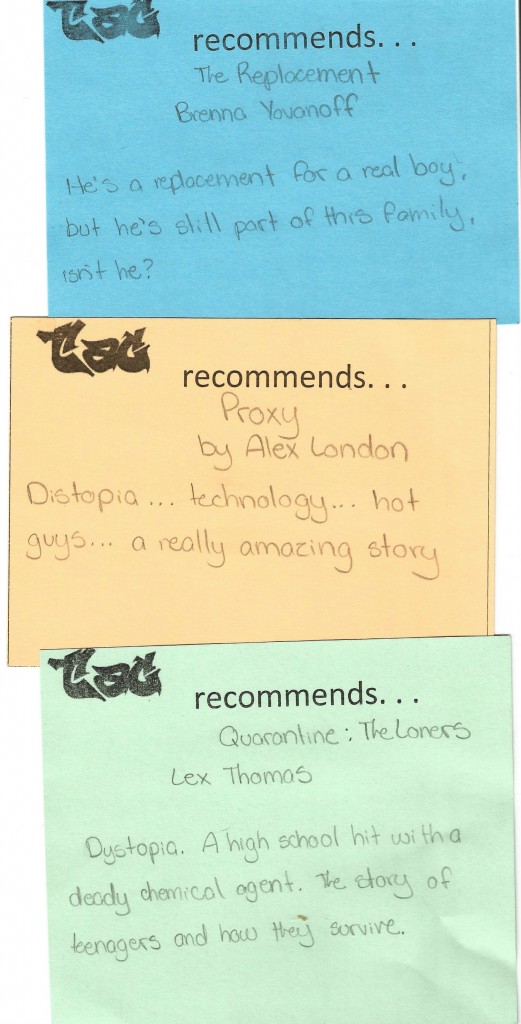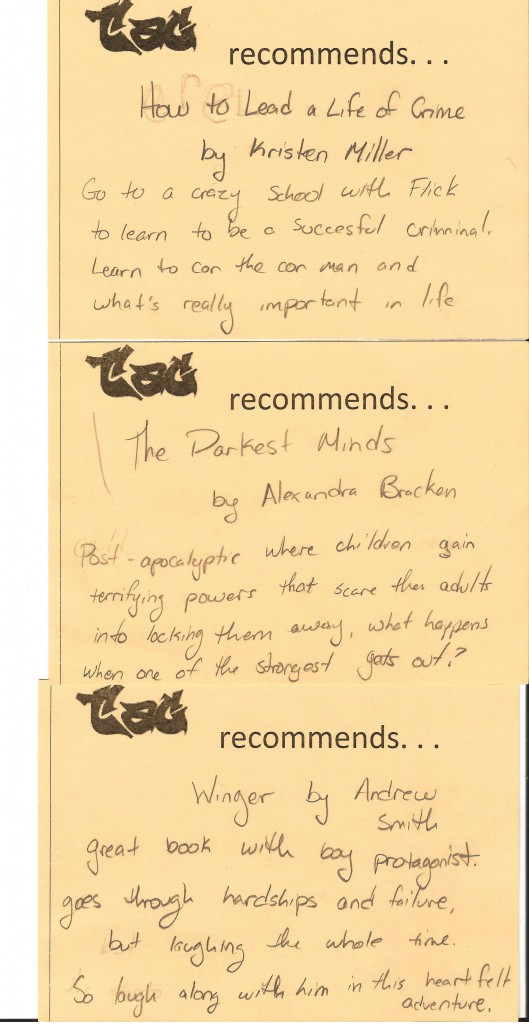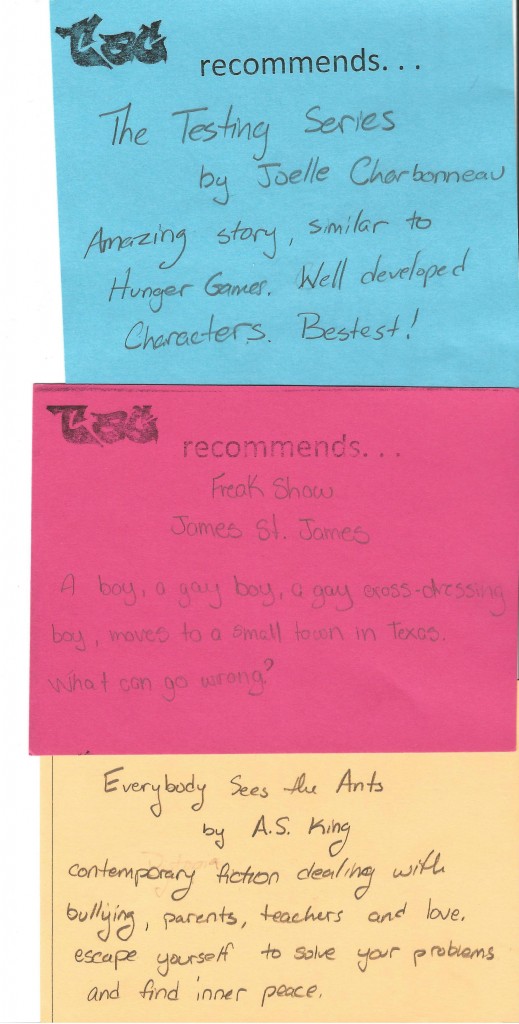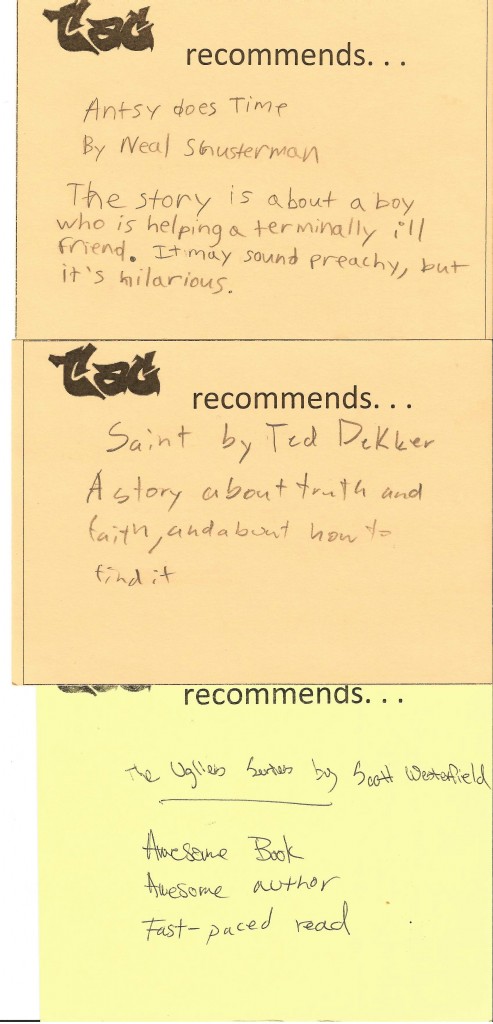I had such a great response to my passive programming post, I thought I’d do two complimentary posts for some of our teen passive programming. These programs have a little more staff involvement but you can easily scale them for what works with your staff time and patron interest and response. Both of these ideas center around the same idea: teens recommending books to teens. Now, don’t get me wrong. I think that nothing can replace a librarian’s expertise and constant booktalking and interacting with teens. We should be THE source in our library for our teen patrons. But. The fact is there are just some teens who will never feel comfortable interacting with staff or teens who primarily want info/recommendations from their peer group or teens who just pop in, pull books off the shelf, and go on their way. AND we should be promoting that conversation whenever we can – teens promoting books to each other is amazing and creates a conversation and excitement around books and reading that’s irreplaceable.
So, how do we support this? One is the way we promote and support the Teens’ Top Ten program, which I’ll discuss tomorrow. Today, I want to discuss our first successful idea: our teen shelf-talkers. We created a small recommended card and are constantly encouraging teens to fill them out. We hang them up on the shelves themselves underneath or beside the books. What’s great about these cards?
- Since there’s only room for a few lines, it’s not a lot of pressure on teens to write an in-depth review. (which many teens feel reluctant or shy about.)
- You can keep them on hand to quickly bring out during conversations with teens or during programs to capture their immediate thoughts. Again, since it’s only a few lines – maybe something they’ve already just said – it’s not as intimidating.
- Our cards read “TAG RECOMMENDS…” TAG standing for our Teen Advisory Group, which is another way to promote this program to teens who might not know we have this group/program. It also lets anyone who fills out one of the cards feel like a member of TAG, further encouraging them to attend meetings.
- Even the simplest of summaries or descriptions works because, well, teens see that other teens have read/written about a book and that alone can be an icebreaker or encouragement.
- These shelf-talkers let the shelves do the talking! Teens who might feel hesitant to interact with staff can still get recommendations and maybe even see that the library welcomes this kind of input and dialogue. It also makes the entire teen collection feel more open – this is a place where lots of talking about books happens, just look around!
So, let’s take a look at the shelf-talkers! We’re constantly soliciting these, of course, but our Winter Reading program for teens this year centered around winning prizes by writing the shelf-talkers. This worked great, we got more entries than ever! I’ve scanned in a few of my favorite samples.
One of my patrons, Desy, is my dynamite superstah when it comes to these blurbs. She has a real feel for phrasing the summaries as questions, which of course is very enticing and very much “if you want to find out what happens, read the book!” which really does work in booktalking for many teen readers. Desy’s good at really short too, which encourages other teens to try their hand at writing summaries. Here’s a handful of her greatest hits.

Another one of my superstars is my teen worker Dillon (who you’ve seen before on this blog and who wants to grow up and be a librarian, wheee!) who has a totally different style from Desy. She writes slightly longer reviews that try to deeply convey her love for books. This is a great counterpoint and also really works for the teens who want longer recommendations. Here are some of her best reviews.

Here are some of Desy’s and Dillon’s together. You can tell whose is whose even without the writing. And, yes, this is the kind of thing other teens pick up on too. (it’s hard to say which I love more: Bestest! or the amazing card for Freak Show.)

But even the shorter reviews can work. Here’s a good sample of shorter reviews, some that are just summaries. These are from some of our younger teens but, again, they still work on a number of levels as I outlined above and (best of all!) encourage all ages of teen readers to get involved. You’ll also see that we let them write reviews of popular books too. I mean: does anyone need a shelf-talker for Uglies or Divergent ? Not really. But the review for Divergent is great and it shows off some love and affection for a popular book/series. The Uglies pitch is just right too. They both say, “You might already know, but we do too! Come talk to us!” And THAT’S just exactly what we want to be encouraging and promoting with these shelf-talkers. (Also the summary for Antsy Does Time might be some of my favorite teen commentary of all-time. Just a reminder that teens always know what’s up.)


As you can see from my scans, we make sure the cards are all on brightly colored cardstock. The teens don’t fill out their names, but sometimes they sign them with a first name.
Do you do this kind or ANY kind of shelf-talking or teen recommendations in your teen area? How do your teen patrons respond if so? Have you had teens positively respond to feedback from other teens in a way they don’t to feedback from staff? Tomorrow, as I said, I’ll do a post about how some of that “teen recommendation” interest/appeal drives our Teens’ Top Ten promotion and display. In the meantime, are there any questions or details about this displays/programs I didn’t answer or that you want more info/samples about? Let’s talk about it all! (Comment here, send me an email, or talk with me on Twitter!)



This sounds like a great idea. My SRP volunteers are eager to begin. I’m curious though, it must take loads of time to make sure the recommended book is still on the shelf. Do you have a system for keeping track?
We don’t really worry about that – although if teens come to the desk and ask for them and they’re out, we’re happy to reserve them. Otherwise, we just like for them to be OUT THERE – for teens to see it’s the kind of opinion they can contribute. Sometimes they find other books by the same author if they’re there. So, mostly we treat it like a regular display – things come and go and we’re always adding. Hope this helps! Let me know if you have some more questions. (you could also work wording about “if this book is checked out, come reserve it” or “if this book is checked out, try ____” onto the cards themselves.)